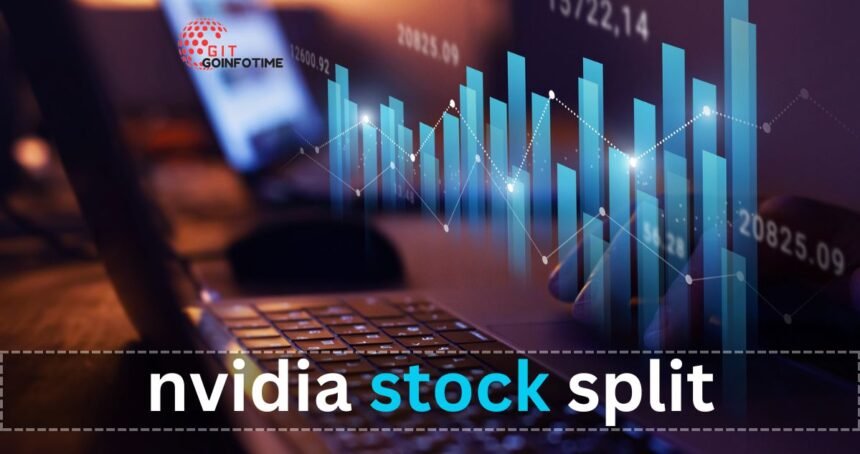NVIDIA stock splits market is full of opportunities, and events like stock splits often spark interest among investors. One of the most talked-about companies in this context is NVIDIA, a global leader in technology and artificial intelligence. NVIDIA stock splits have made its shares more accessible to a wider audience, enhancing investor participation.
In this article, we’ll provide a detailed overview of NVIDIA stock split, including their history, benefits, and how they influence the company’s market performance. Whether you’re a seasoned investor or just starting out, understanding stock splits can empower you to make smarter financial decisions.
What is an NVIDIA Stock Split?
A stock split occurs when a company divides its existing shares into multiple new ones, reducing the price per share without altering the overall market capitalization. NVIDIA, known for its dominance in the semiconductor and AI industries, uses stock splits to maintain investor interest and affordability.
For example, if NVIDIA announces a 4-for-1 stock split, each shareholder will receive four shares for every one they own, but the price of each share will be adjusted proportionally. This keeps the total value of the investment unchanged.
History of NVIDIA Stock Splits
Stock splits are not new for NVIDIA. The company has undertaken several splits in its history to maintain accessibility and ensure liquidity in the market. Here’s a brief look at NVIDIA’s stock split history:
| Date | Split Ratio | Approximate Price Pre-Split | Approximate Price Post-Split |
|---|---|---|---|
| June 27, 2000 | 2-for-1 | $100 | $50 |
| September 11, 2001 | 2-for-1 | $80 | $40 |
| April 6, 2006 | 2-for-1 | $64 | $32 |
| July 20, 2007 | 3-for-2 | $30 | $20 |
| July 20, 2021 | 4-for-1 | $750 | $187 |
These splits reflect NVIDIA’s growth and its strategy to make its shares more appealing to individual investors.
Why Do Companies Like NVIDIA Perform Stock Splits?
Companies perform stock splits for several reasons:
- Attracting Retail Investors: High stock prices can deter small investors. A stock split lowers the price per share, making it more affordable.
- Increasing Liquidity: By increasing the number of shares in circulation, companies like NVIDIA ensure easier trading in the stock market.
- Signaling Confidence: A stock split is often a positive signal, indicating that a company anticipates future growth.
For NVIDIA, stock splits have been a strategic tool to maintain its leadership in the tech industry while democratizing ownership.
NVIDIA’s Most Recent Stock Split

NVIDIA’s latest stock split took place on July 20, 2021. It was a 4-for-1 split, which reduced the stock price from approximately $750 to $187 per share. This move came at a time when NVIDIA was experiencing significant growth due to increased demand for GPUs and AI technologies.
Market Reactions
The announcement of the split was met with enthusiasm. NVIDIA’s stock saw a temporary boost as investors anticipated increased accessibility and liquidity. Analysts viewed the split as a sign of the company’s confidence in its long-term potential.
Impact of NVIDIA Stock Splits on Shareholders
Short-Term Effects
- Price Adjustment: After a split, the stock price is reduced, but the total value of an investor’s holdings remains unchanged.
- Increased Demand: Lower prices often attract more buyers, boosting trading volume and potentially raising the stock’s value.
Long-Term Effects
Historically, NVIDIA’s stock splits have aligned with periods of strong growth. For long-term shareholders, these splits have often been a precursor to significant value appreciation as the company continues to expand.
Bio Table: Key Details About NVIDIA Corporation
Here’s an overview of NVIDIA Corporation and its market presence:
| Attribute | Details |
|---|---|
| Company Name | NVIDIA Corporation |
| Founded | 1993 |
| Headquarters | Santa Clara, California, USA |
| Industry | Semiconductors, Artificial Intelligence |
| Key Products | GPUs, AI Hardware, Cloud Computing Solutions |
| CEO | Jensen Huang |
| Market Cap (2025) | Over $1 Trillion |
This bio table underscores NVIDIA’s significance in the tech world and its strong market position.
How NVIDIA Stock Splits Affect Small Investors
Stock splits, especially by prominent companies like NVIDIA, significantly benefit small investors:
- Lower Entry Barriers: Reduced share prices make it easier for individual investors to buy shares.
- Broader Ownership: Splits attract a diverse range of investors, increasing the stock’s market reach.
- Enhanced Flexibility: Investors can buy more shares without committing large sums of money.
Post-Split Performance of NVIDIA Stocks
Following its 2021 split, NVIDIA’s stock continued to grow, driven by advancements in AI, gaming, and cloud computing. The company’s ability to maintain robust financial performance has solidified its reputation as a tech powerhouse.
Key Trends
- Revenue Growth: NVIDIA’s revenue has consistently increased, reflecting strong demand for its products.
- Market Expansion: The company’s entry into new industries, such as automotive AI, has broadened its growth potential.
FAQs
Q1: Why does NVIDIA perform stock splits?
To make shares more affordable, attract retail investors, and increase market liquidity.
Q2: How does a stock split affect the stock’s value?
The stock’s value remains unchanged, but the price per share is reduced proportionally to the split ratio.
Q3: Is a stock split a good time to buy NVIDIA shares?
It depends on your investment strategy and market conditions. Historically, NVIDIA shares have performed well post-split.
Q4: How often has NVIDIA split its stock?
NVIDIA has split its stock five times since its IPO.
Q5: Do stock splits guarantee future growth?
No, but they often indicate confidence in a company’s long-term potential.
Conclusion
NVIDIA stock splits are more than just a financial event—they’re a testament to the company’s growth, market dominance, and investor-friendly approach. Whether you’re a new investor or a seasoned one, understanding stock splits can help you make informed decisions. NVIDIA’s consistent innovation and strategic moves make it a stock worth considering for long-term growth.





